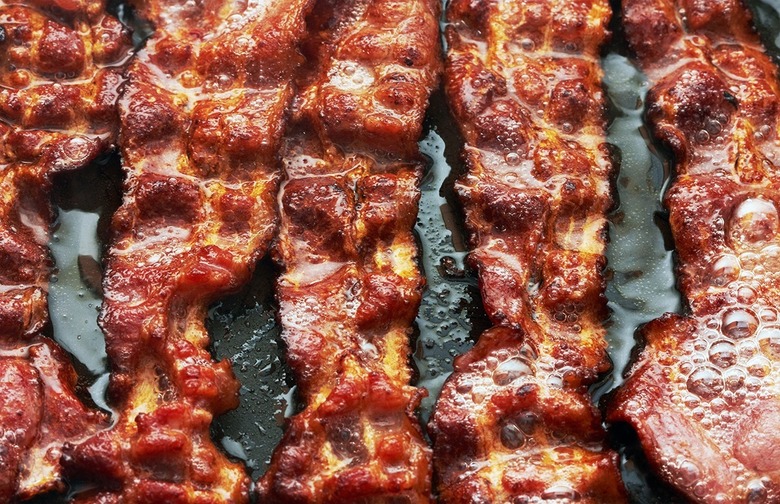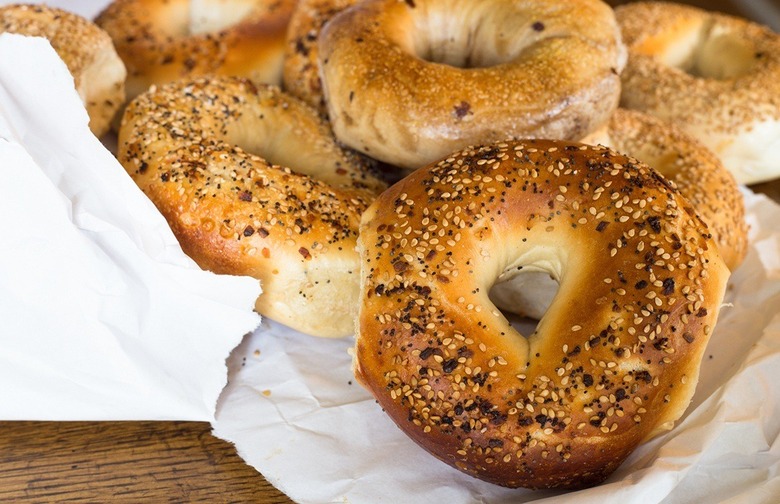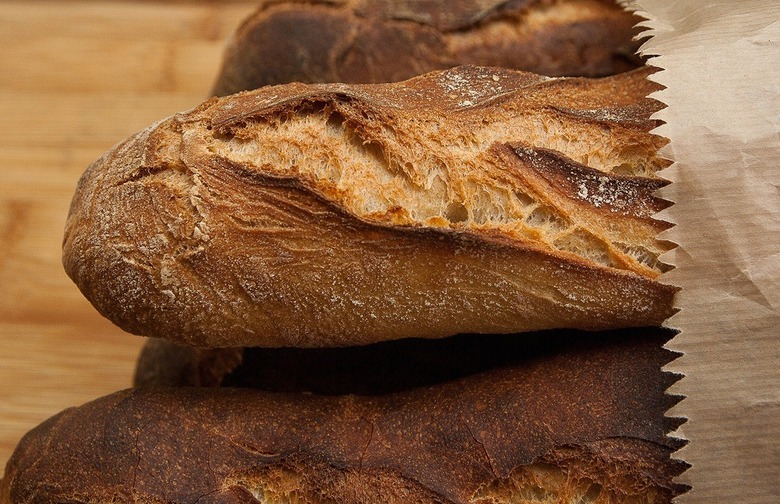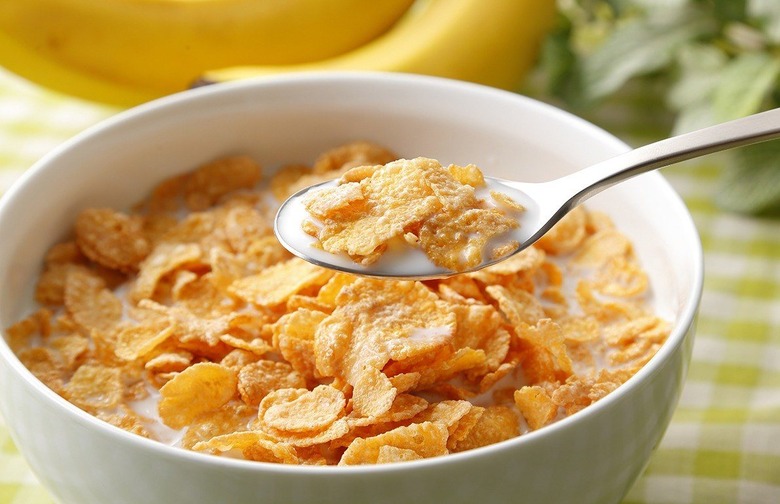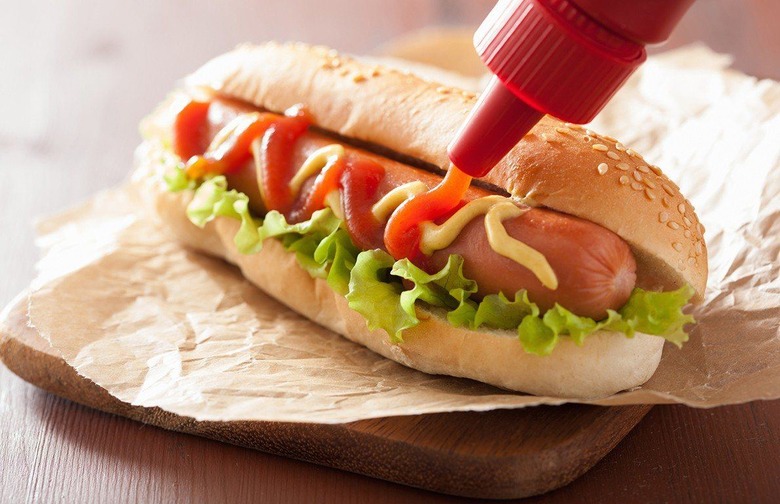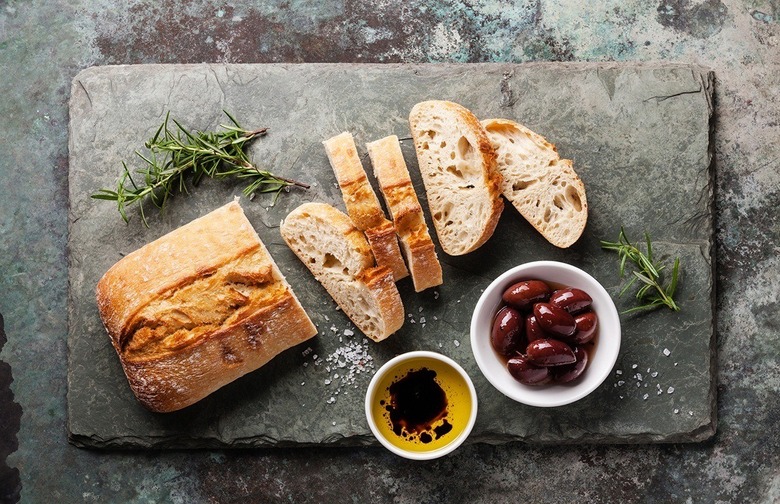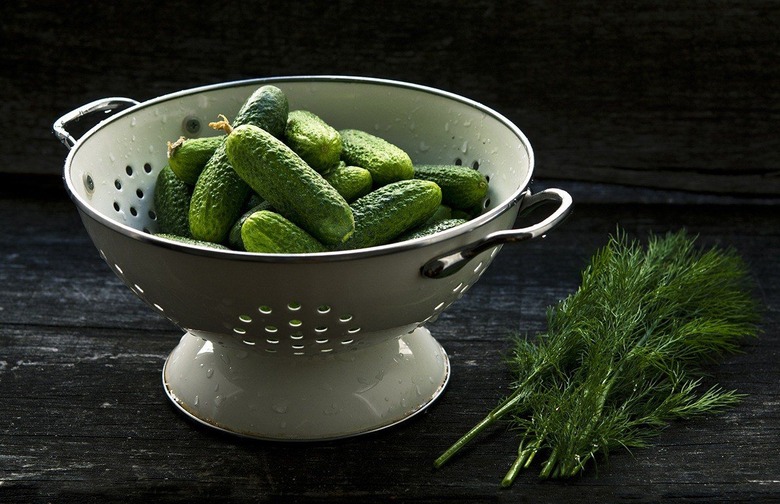You Won't Believe How Much Salt Is In These 26 Common Foods Slideshow
Bacon is a preserved pork product (usually taken from the pig's fatty belly), that's either cured in a brine or dry-packed with salt and spices, and then smoked. Bacon is versatile and delicious, but it should be used as a flavoring agent because of its high sodium content. One ounce of bacon contains around 400 milligrams of sodium, a little less than 20 percent of your recommended daily allowance. Pair it with eggs, home fries, and toast, and you're looking at a super salty breakfast.
Bagels
A bagel with cream cheese is a satisfying breakfast (especially after a night of debauchery), but it's certainly not the healthiest. Besides being comprised almost entirely of bleached white flour, bagels also contain a surprising amount of sodium — as much as 20 percent of your recommended daily allowance.
Blue Cheese
Whether it's in a cooling dip for chicken wings or crumbled atop a Cobb salad, blue cheese is certainly no diet food. It's also a sodium bomb. A half-cup of crumbled blue cheese contains more than half a day's worth of sodium.
Bread
When you think of salt, white bread isn't the first thing that comes to mind, but sodium is the major contributor to processed bread's flavor. Two slices of wheat bread contain 300 milligrams of sodium — add some sliced deli meats and a squeeze of mayo and you're looking upwards of 1,200 milligrams of sodium.
Bread Crumbs
A box of bread crumbs seems innocent enough; it's just pulverized, stale bread, right? Unfortunately this isn't the case. To make bread crumbs taste flavorful and delicious, manufacturers add copious amounts of salt and seasonings, which drastically distorts the nutritional content. One cup of seasoned bread crumbs contains a shocking 2,111 milligrams of sodium, which is almost an entire day's recommended allowance. Next time you've got a stale loaf of bread in the pantry, transform it into your own healthier breadcrumbs.
Breakfast Sandwiches
A carefully constructed, homemade breakfast sandwich is a fine way to start the day, but most fast-food and frozen breakfast sandwiches are poor choices. According to the USDA, the average egg and cheese sandwich (without any sausage or bacon) has 804 milligrams of sodium, more than 30 percent of your recommended daily allowance. (There are some exceptions — here are some of the healthiest fast-food breakfast sandwiches.)
Canned Beans
Legumes are rich in fiber, protein, and other minerals, and are, in some ways, the perfect plant-based protein, but the canned variety sometimes suffers from too much added sodium. However, draining the canning liquid and giving the beans a good rinse can reduce their sodium content by as much as 40 percent.
Canned Baked Beans
There's a significant difference between the nutrition content of a can of black, kidney, or pinto beans, and a can of baked beans. The latter is loaded with sugar, salt, and other flavorings, with one cup containing 24 grams of sugar and 1100 milligrams of salt. Avoid the canned variety, and make this Boston baked bean dip instead.
Canned Ravioli
A 15-ounce can of beef ravioli is only 220 calories, which isn't terrible, but the sodium content makes this an unideal option for those watching their blood pressure. Canned ravioli offers little in the way of nutrition but still contains almost a third of the day's recommended allowance of sodium. If you love ravioli (and who doesn't), explore some of The Daily Meal's best ravioli recipes.
Canned Soup
Canned soup is notoriously high in salt — it is necessary to bring out the flavor and make the soup palatable — and although it's convenient, it's still nothing compared to homemade chicken soup. A half-cup serving of a popular brand's condensed chicken noodle soup contains 37 percent of the recommended daily allowance of sodium.
Cereal
It might be hard to believe, but even your favorite breakfast cereal contains some salt. Two cups of corn flakes, which isn't even the unhealthiest breakfast cereal, contains just a little less than 20 percent of your RDA of sodium. Be careful of breakfast cereal if you suffer from high blood pressure.
Cottage Cheese
Cottage cheese is a throwback food that was probably more popular with your grandma (and is also a powerful, muscle-building snack), but the textured dairy product can be deceivingly high in sodium. A cup of regular cottage cheese packs a third of the days' worth of sodium.
Deli Meats
Sliced deli meats are an affordable and convenient lunch option. Slap a few slices on some toasted bread with a squirt of mustard and you're ready to go, but deli meat gets its flavor from being pumped full of salt. Four slices of lunch meat (around four ounces) contain over half of the day's daily recommended allowance of sodium — and may even kill your sex drive.
Flour Tortillas
The unhealthiest component of a burrito isn't the rice, beans, meat, cheese, or guacamole — it's the tortilla. An eight-inch tortilla contains 300 calories, and more than one third of the recommended daily allowance of sodium. When at Chipotle Mexican Grill or Moe's Southwest Grill, opt for the burrito bowl.
Frozen Pizza
Without salt, frozen pizza would taste like cardboard. One popular brand loads on the sodium, with half a pie (two servings according to the packaging) containing 1,500 milligrams, or over 50 percent of the recommended daily allowance. Here are the 11 best frozen pizzas.
“Healthy” Frozen Meals
Premade frozen entrees shouldn't be frowned upon; their cost and convenience makes them reliable dinner options. Healthier brands, such as Amy's, use some organic ingredients, but the taste of frozen foods really suffers when they are under seasoned, and most manufacturers still include quite a bit of salt. A 10-ounce serving of a black bean tamale verde contains a third of the RDA of sodium.
Imitation Crab Meat
The long sticks of crab-flavored seafood nestled within California rolls are a Japanese culinary creation known as "surimi." The paste, which is commonly made from ground fish, is a heavily processed product that becomes "crab-like" after the addition of egg white, salt, vegetable oil, and other flavor enhancers and stabilizers. Three ounces of surimi packs a third of a day's recommended allowance of sodium.
Ketchup
The sweetness of this seemingly harmless condiment is the perfect foil to salty French fries (and these seven other unusual dishes), but ketchup has its own sodium issues. Two tablespoons of ketchup has 300 milligrams of sodium, which can really add up if accompanying a big serving of fries.
Olives
Munching on a bowl of pitted Kalamata olives isn't an ideal dinner, but if you're stranded and hungry at a cocktail party sometimes you need to do what it takes to survive. Unfortunately, these briny, bite-sized morsels are salt bombs, with a half-cup of olives providing more than half a day's recommended allowance of sodium.
Packaged Ramen Noodles
The powdered stocks (it could be beef, chicken, shrimp, or mushroom depending on your preference) that give ramen noodles their signature flavor are loaded with salt. One package of this college dorm room staple contains 1,731 milligrams of sodium, around three-quarters of your recommended daily intake.
Pickles
Pickling is a centuries-old preservation method that uses salt and vinegar to prohibit the growth of bacteria, but submerging vegetables into salty brine dramatically boosts their sodium content. One dill pickle contains between 500 and 1100 milligrams of sodium, almost half of the recommended daily allowance.
Salad Dressing
A drizzle of balsamic vinaigrette, sesame ginger, or creamy Caesar makes bland salad greens worth eating, but don't overdo it on dressings. Most are highly concentrated, and only a tablespoon can load on more than a quarter of your recommended daily allowance of sodium. To cut back on the salt content, make your own dressings at home. These will save you money, calories, sodium, and can be stored for weeks in the refrigerator.
Sliced Processed Cheese
Adding a slice of cheese to a burger, breakfast sandwich, or hoagie roll is an easy way to overdo it on the salt. One Kraft Singles slice of American cheese contains nine percent of the recommended daily allowance of sodium, which may not seem like a lot, but relative to weight (a slice is less than one ounce) it's quite considerable.
Spaghetti Sauce
Tomato sauces range in sodium content from 400 milligrams per half cup all the way to 680 milligrams. Most of these sauces advertise their vegetable content, but fail to acknowledge their sky-high sodium. Tomato sauce is also notoriously high in sugar.
Veggie Burgers
With such a variety of plant-based burger options out there, it's irresponsible to make sweeping generalizations, but many frozen veggie burgers have high sodium content relative to calories. A three-ounce Gardenburger Chipotle Black Bean Veggie Burger contains only 90 calories — but 390 milligrams of sodium (around 20 percent of your RDA).
Vegetable Juice
Although companies are releasing low-sodium versions of vegetable juice, conventional recipes still pack in the salt. One eight-ounce serving of V8 Original Vegetable Juice contains 640 milligrams of sodium, more than 25 percent of your RDA.
